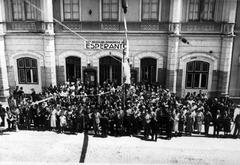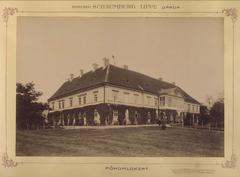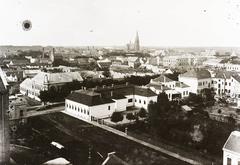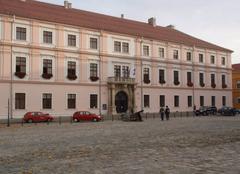
Castra Mursa Visiting Hours, Tickets, and Osijek Historical Sites Guide
Date: 15/06/2025
Introduction
Castra Mursa, an ancient Roman military camp and settlement on the right bank of the Drava River, is the foundation upon which modern Osijek, Croatia, is built. Established in the early 1st century AD, Castra Mursa evolved into a crucial strategic, economic, and cultural hub in the Roman province of Pannonia. Its significance was cemented in 133 AD, when Emperor Hadrian elevated it to Colonia Aelia Mursa, transforming the site into a center of both military command and civilian life. Today, visitors can explore Osijek’s Roman heritage through archaeological remains, museum exhibits, and city walks connecting the ancient past with Osijek’s vibrant present (mso.hr, tzosijek.hr).
This comprehensive guide offers essential information for planning a visit to Castra Mursa and Osijek’s historic sites, including practical details on visiting hours, ticketing, guided tours, accessibility, and cultural highlights. Whether you are a history enthusiast or a curious traveler, use this guide to enrich your exploration of one of Croatia’s most fascinating Roman heritage destinations.
Contents
- Introduction
- Historical Overview of Castra Mursa
- Urban Layout and Archaeology
- Cultural and Economic Life
- Military Significance and Key Events
- Archaeological Discoveries
- Influence on Modern Osijek
- Visitor Information
- Location and Access
- Visiting Hours
- Tickets and How to Buy
- Guided Tours
- Accessibility
- Photography and Etiquette
- Special Events
- Nearby Attractions
- Visual and Media Resources
- Frequently Asked Questions (FAQ)
- Conclusion and Visitor Recommendations
- Sources and Further Reading
Historical Overview of Castra Mursa
Castra Mursa was founded in the early 1st century AD, selected for its strategic riverine location and proximity to key trade routes. The Drava River served as a natural frontier for the Roman Empire, making Mursa a core component of the defensive limes system (cosy.sbg.ac.at). Originally inhabited by Illyrian tribes, the area was taken over by Rome under Emperor Augustus and developed into a military base, later becoming a thriving civilian settlement.
The city gained colonia status under Hadrian, granting it self-governance and integrating it more deeply into the Roman administrative structure (whc.unesco.org). The presence of the Lower Pannonia governor and the Danube Navy Prefect attests to its regional importance.
Urban Layout and Archaeology
Castra Mursa followed a classic Roman military camp design—rectangular, fortified, and organized with a grid street pattern. Key urban features included:
- Fortified walls and towers
- A central forum, temples, and public baths
- A significant brick bridge over the Drava River, vital for both military and trade purposes (cosy.sbg.ac.at)
Modern archaeological investigations, particularly in Osijek’s Lower Town and Tvrđa district, have uncovered sections of ancient walls, gates, streets, and domestic buildings (whc.unesco.org).
Cultural and Economic Life
Mursa was situated at the intersection of six major Roman roads, fostering a bustling center for trade, crafts, and agriculture. Archaeological finds, including coins, imported ceramics, and luxury items, reflect the city’s affluence and multicultural character (whc.unesco.org). The city played a notable role in early Christianity, becoming a bishopric by the 2nd century and home to influential figures such as Bishop Valens.
Military Significance and Key Events
Castra Mursa was the site of major historical events, most notably the Battle of Mursa Major in 351 AD, a devastating civil conflict within the Roman Empire (whc.unesco.org). The aftermath of this and subsequent invasions by Gothic and Hunnic tribes contributed to the city’s decline and eventual abandonment in the 5th century.
Archaeological Discoveries
Archaeological research has revealed:
- Remains of stone walls, foundations of gates, and defensive ditches
- Artifacts such as Roman coins, ceramics, military equipment, and inscribed stelae
- A notable Roman glass lamp fragment discovered on Branko Radičević Street (academia.edu)
- The Roman urban grid influencing Osijek’s later medieval and Baroque development (academia.edu)
Many of these finds are exhibited at the Museum of Slavonia and the Archaeological Museum Osijek.
Influence on Modern Osijek
The Roman legacy is visible in Osijek’s urban layout, especially in Tvrđa, and in the city’s ongoing cultural traditions. The Drava River remains central to Osijek’s identity and development. Castra Mursa’s story is celebrated through museum exhibits, interpretive panels, and annual cultural events (mexicohistorico.com, dkiel.com).
Visitor Information
Location and Access
- Main Archaeological Zone: Osijek’s Lower Town, especially near Branko Radičević Street and the Tvrđa (Citadel) district (mapcarta.com)
- Access: Easily reached on foot from the city center; trams, buses, and parking available nearby (wildtrips.net)
Visiting Hours
- Museum of Slavonia: Tuesday to Sunday, 10:00 AM – 6:00 PM; closed Mondays (evaneos.com)
- Archaeological Museum Osijek: Similar hours; verify on official website
- Outdoor Archaeological Sites: Open year-round, no restricted hours
Tickets and How to Buy
- Museum Entry: 3–6 EUR (20–40 HRK), with discounts for students, seniors, and families; tickets sold at museum entrances and online via official websites
- Open-Air Sites: Free access
Guided Tours
- Tours Offered: Local agencies and the Osijek Tourist Board organize guided walks focused on Roman and medieval heritage (pg.world, tzosijek.hr)
- Languages: Croatian, English, and others by request
- Booking: Recommended in advance, especially during peak season
Accessibility
- Museums: Wheelchair accessible
- Tvrđa District: Mostly accessible; cobblestone streets may pose challenges
Photography and Etiquette
- Photography: Allowed in outdoor areas; check museum policies for indoor exhibits
- Visitor Etiquette: Respect marked archaeological zones and preservation efforts
Special Events
- Osijek City Day (December 2): Focuses on the city’s Roman origins (entercroatia.com)
- Osijek Summer Nights (June–August): Open-air performances and historical reenactments (tzosijek.hr)
- Museum Nights (January): Free evening museum programs with Roman heritage themes
Nearby Attractions
- Tvrđa Fortress: Baroque architecture and cultural center
- Osijek Cathedral: Neo-Gothic landmark
- Kopački Rit Nature Park: UNESCO biosphere reserve (ilcroatia.com)
- Regional Towns: Vinkovci, Vukovar, and Ilok with Roman and medieval sites
Visual and Media Resources
Enhance your visit with:
- Virtual Tours: Available on the Museum of Slavonia and Osijek Tourist Board websites
- Interactive Maps: Indicate archaeological points of interest throughout the city
- Photo Galleries: Roman artifacts, Tvrđa’s architecture, and festival scenes
Frequently Asked Questions (FAQ)
Q: What are Castra Mursa visiting hours?
A: Outdoor archaeological areas are freely accessible at any time. Museums (e.g., Museum of Slavonia) are open Tuesday to Sunday, 10:00 AM – 6:00 PM.
Q: How do I buy tickets for Castra Mursa exhibits?
A: Purchase tickets at museum entrances or through official websites.
Q: Are the sites accessible for wheelchair users?
A: Museums and most of Tvrđa are accessible; some cobblestone streets may be challenging.
Q: Are guided tours available in English?
A: Yes, with advance booking through local agencies or the Osijek Tourist Board.
Q: When is the best time to visit?
A: May–September for pleasant weather and active cultural events.
Conclusion and Visitor Recommendations
Castra Mursa stands as a bridge between ancient Roman civilization and the vibrant modern city of Osijek. Visitors can delve into centuries of history through museum collections, interpretive walks, and lively festivals reflecting Osijek’s layered heritage. For the latest updates on visiting hours, tickets, and upcoming events, consult the Osijek Tourist Board and Museum of Slavonia. Enhance your experience with the Audiala app for audio guides and event updates, and follow local tourism channels for the latest news. Plan your journey and immerse yourself in the enduring legacy of Castra Mursa and Osijek’s historic sites (magazin.hrt.hr).
Sources and Further Reading
- Visiting Castra Mursa: History, Tickets, Hours & Osijek Historical Sites Guide, 2025, (whc.unesco.org)
- Exploring Castra Mursa: Visiting Hours, Tickets, and Historical Sites in Osijek, 2025, (ilcroatia.com)
- Castra Mursa Visiting Hours, Tickets, and Guide to Osijek’s Historic Roman Site, 2025, (tzosijek.hr)
- Exploring Castra Mursa and Tvrđa in Osijek: Visiting Hours, Tickets, and Cultural Highlights, 2025, (essenceofcroatia.com)
- A Fragment of a Glass Lamp from Roman Mursa, 2025, (academia.edu)
- Aelia Mursa: New Reading of the City, 2025, (academia.edu)
- Exploring Osijek: A Historical Overview of Croatia, 2025, (mexicohistorico.com)
- Osijek Travel Guide, 2025, (ilcroatia.com)
- Osijek Tourist Board Official Website, 2025, (tzosijek.hr)
- Museum of Slavonia Official Website, 2025, (mso.hr)





